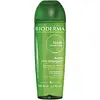What's inside
What's inside
 Key Ingredients
Key Ingredients

 Benefits
Benefits

 Concerns
Concerns

 Ingredients Side-by-side
Ingredients Side-by-side

Water
Skin ConditioningCaprylyl/Capryl Glucoside
CleansingPEG-150 Distearate
EmulsifyingPEG-6 Caprylic/Capric Glycerides
EmulsifyingPEG-15 Cocopolyamine
EmulsifyingSodium Lauroyl Oat Amino Acids
CleansingLactic Acid
BufferingSodium Citrate
BufferingCaprylyl Glycol
EmollientQuaternium-80
Propylene Glycol
HumectantMannitol
HumectantXylitol
HumectantRhamnose
HumectantPhenoxyethanol
PreservativeTetrasodium EDTA
Ethylhexylglycerin
Skin ConditioningFructooligosaccharides
HumectantSodium Hydroxide
BufferingParfum
MaskingWater, Caprylyl/Capryl Glucoside, PEG-150 Distearate, PEG-6 Caprylic/Capric Glycerides, PEG-15 Cocopolyamine, Sodium Lauroyl Oat Amino Acids, Lactic Acid, Sodium Citrate, Caprylyl Glycol, Quaternium-80, Propylene Glycol, Mannitol, Xylitol, Rhamnose, Phenoxyethanol, Tetrasodium EDTA, Ethylhexylglycerin, Fructooligosaccharides, Sodium Hydroxide, Parfum
Water
Skin ConditioningIsopropyl Palmitate
EmollientStearyl Alcohol
EmollientPropanediol
SolventIsopentyldiol
HumectantBehentrimonium Chloride
PreservativeTocopherol
AntioxidantTocopheryl Acetate
AntioxidantSh-Oligopeptide-78
Alteromonas Ferment Extract
Skin ConditioningPrunus Amygdalus Dulcis Oil
Skin ConditioningSimmondsia Chinensis Seed Oil
EmollientPhospholipids
Skin ConditioningJojoba Esters
EmollientCalcium Gluconate
HumectantHydroxypropyl Guar Hydroxypropyltrimonium Chloride
Ceramide NP
Skin ConditioningPhytosteryl/Isostearyl/Cetyl/Stearyl/Behenyl Dimer Dilinoleate
Skin ConditioningPolyquaternium-16
Stearalkonium Chloride
PreservativeIsopropyl Alcohol
SolventButylene Glycol
HumectantGluconolactone
Skin ConditioningPhenoxyethanol
PreservativeSodium Benzoate
MaskingCitric Acid
BufferingSodium Hydroxide
BufferingParfum
MaskingHydroxycitronellal
PerfumingWater, Isopropyl Palmitate, Stearyl Alcohol, Propanediol, Isopentyldiol, Behentrimonium Chloride, Tocopherol, Tocopheryl Acetate, Sh-Oligopeptide-78, Alteromonas Ferment Extract, Prunus Amygdalus Dulcis Oil, Simmondsia Chinensis Seed Oil, Phospholipids, Jojoba Esters, Calcium Gluconate, Hydroxypropyl Guar Hydroxypropyltrimonium Chloride, Ceramide NP, Phytosteryl/Isostearyl/Cetyl/Stearyl/Behenyl Dimer Dilinoleate, Polyquaternium-16, Stearalkonium Chloride, Isopropyl Alcohol, Butylene Glycol, Gluconolactone, Phenoxyethanol, Sodium Benzoate, Citric Acid, Sodium Hydroxide, Parfum, Hydroxycitronellal
 Reviews
Reviews

Alternatives
Ingredients Explained
These ingredients are found in both products.
Ingredients higher up in an ingredient list are typically present in a larger amount.
Parfum is a catch-all term for an ingredient or more that is used to give a scent to products.
Also called "fragrance", this ingredient can be a blend of hundreds of chemicals or plant oils. This means every product with "fragrance" or "parfum" in the ingredients list is a different mixture.
For instance, Habanolide is a proprietary trade name for a specific aroma chemical. When used as a fragrance ingredient in cosmetics, most aroma chemicals fall under the broad labeling category of “FRAGRANCE” or “PARFUM” according to EU and US regulations.
The term 'parfum' or 'fragrance' is not regulated in many countries. In many cases, it is up to the brand to define this term.
For instance, many brands choose to label themselves as "fragrance-free" because they are not using synthetic fragrances. However, their products may still contain ingredients such as essential oils that are considered a fragrance by INCI standards.
One example is Calendula flower extract. Calendula is an essential oil that still imparts a scent or 'fragrance'.
Depending on the blend, the ingredients in the mixture can cause allergies and sensitivities on the skin. Some ingredients that are known EU allergens include linalool and citronellol.
Parfum can also be used to mask or cover an unpleasant scent.
The bottom line is: not all fragrances/parfum/ingredients are created equally. If you are worried about fragrances, we recommend taking a closer look at an ingredient. And of course, we always recommend speaking with a professional.
Learn more about ParfumPhenoxyethanol is a preservative that has germicide, antimicrobial, and aromatic properties. Studies show that phenoxyethanol can prevent microbial growth. By itself, it has a scent that is similar to that of a rose.
It's often used in formulations along with Caprylyl Glycol to preserve the shelf life of products.
Sodium Hydroxide is also known as lye or caustic soda. It is used to adjust the pH of products; many ingredients require a specific pH to be effective.
In small amounts, sodium hydroxide is considered safe to use. However, large amounts may cause chemical burns due to its high alkaline.
Your skin has a natural pH and acid mantle. This acid mantle helps prevent harmful bacteria from breaking through. The acid mantle also helps keep your skin hydrated.
"Alkaline" refers to a high pH level. A low pH level would be considered acidic.
Learn more about Sodium HydroxideWater. It's the most common cosmetic ingredient of all. You'll usually see it at the top of ingredient lists, meaning that it makes up the largest part of the product.
So why is it so popular? Water most often acts as a solvent - this means that it helps dissolve other ingredients into the formulation.
You'll also recognize water as that liquid we all need to stay alive. If you see this, drink a glass of water. Stay hydrated!
Learn more about Water